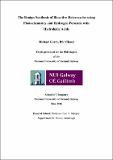| dc.description.abstract | Chapter 1 provides a pertinent review of recent photochemical homolytic aromatic substitution (HAS) literature. Photochemical methods for HAS include UV-light and visible light photoredox catalysis. Recently invented methods have resulted in a dramatic decline in the use of Bu3SnH for HAS.
Chapter 2 describes the preparation of (E)-3-ylideneoxindoles using UV-light mediated 5-exo-trig of aryl radicals. X-ray crystal structure of (2E)-N-methyl-2-(1-methyl-2-oxo-1,2-dihydro-3H-indol-3-ylidene)-N-(phenylsulfonyl)acetamide confirmed the 5-exo-trig adduct and (E)-geometry.
Chapter 3 describes the synthesis of the spirocyclic oxetane, 2-oxa-7-azaspiro[3.5]nonane. X-ray crystal structure of 7ʹ-bromo-1ʹ,2ʹ-dihydro-4ʹH-spiro[oxetane-3,3ʹ-pyrido[1,2-a] benzimidazole] confirmed the fusion of the spirocyclic oxetane as [1,2-a] ring-fused benzimidazole. X-ray crystal structure of N-(2-acetamido-4-bromophenyl)-N-{[3-(chloromethyl)oxetan-3-yl]methyl}acetamide confirmed azetidine ring-opening of 2-oxa-6-azaspiro[3.3]heptane.
Chapter 4 describes the synthesis of a new series of selectively dichlorinated and dibrominated five to eight-membered ring-fused benzimidazoles. High yields of >80% are reported from the reaction of hydrogen peroxide and hydrohalic acid (HCl and HBr) with commercially available o-cyclic amine substituted anilines. Domestic bleach with HCl is capable of a one-pot ring-closure and dichlorination. X-ray crystal structures of 8-bromo-7,9-dichloro-3,4-dihydro-1H-[1,4]oxazino[4,3-a]benzimidazole, 7,9-dichloro-8-(trifluoromethyl)-3,4-dihydro-1H-[1,4]oxazino[4,3-a]benzimidazole, 6,8-dibromo-1,2,3,4-tetrahydropyrido [1,2-a]benzimidazole, 6,8-dibromo-7-fluoro-1,2,3,4-tetrahydropyrido[1,2-a]benzimidazole, and 6,8-dibromo-7-methoxy-1,2,3,4-tetrahydropyrido[1,2-a]benzimidazole were obtained that demonstrated the specificity of the halogenation.
Chapter 5 describes the one-pot synthesis of dichlorinated and dibrominated pyrrolo- and pyrido[1,2-a] ring-fused benzimidazolequinones as potential anti-tumor agents from 3,6-dimethoxy-2-(cycloamino)anilines using hydrogen peroxide and HCl/HBr. Three steps are carried out in one-pot, namely oxidative cyclization to give the benzimidazole, aromatic halogenation, and oxidative-demethylation to give the quinone. HI with hydrogen peroxide is reported to give cyclized benzimidazoles from 3,6-dimethoxy-2-(cycloamino)anilines.
Chapters 2-5 contain experimental sections within. | en_IE |


